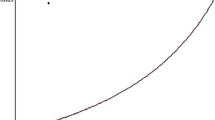Abstract
We extend the basic model of spatial competition in two directions. First, political parties and voters do not have complete information but behave adaptively. Political parties use polls to search for policy platforms that maximize the probability of winning an election and the voting decision of voters is influenced by social interaction. Second, we allow for the emergence of interest groups. These interest groups transmit information about voter preferences to the political parties, and they coordinate voting behavior. We use simulation methods to investigate the convergence properties of this model. We find that the introduction of social dynamics and interest groups increases the separation between parties platforms, prohibits convergence to the center of the distribution of voter preferences, and increases the size of the winning set.
Similar content being viewed by others
References
Akerlof, G.A., & Kranton, R.E. (2002). Economics and identity. Quarterly Journal of Economics, 115, 715–753.
Ansolobehere, S., de Figueiredo, J.M., & Snyder, J.M. (2002). Why is there so little money in U.S. politics? NBER Working Paper 9409.
Banerjee, A.V. (1992). A simple model of herd behavior. Quarterly Journal of Economics, 61, 29–56.
Bikhchandani, S., Hirshleifer, D., & Welch, I. (1992). A theory of fads, fashion, custom, and cultural change as informational cascades. Journal of Political Economy, 100, 992–1026.
Camerer, C.F. (2002). Behavioral game theory: experiments on strategic interaction, princeton: princeton University Press.
Corradi, V., & Ianni, A. (1998). Consensus and co-existence in an interactive process of opinion formation. CARESS Working Paper 98–09. University of Pennsylvania.
Coughlin, P.J. (1990). Majority rule and election models. Journal of Economic Surveys, 4, 157–188.
De, Marchi, S. (2003). A computational model of voter sophistication, ideology, and candidate position taking. In: K. Kollman, J.H. Miller & S.E. Page (eds.), Computational Models in Political Economy, Cambridge, MA: MIT Press.
Grossman, G.M., & Helpman, E. (1999). Competing for endorsements. American Economic Review, 89, 501–524.
Hinich, M.J., & Munger M.C. (1997). Analytical politics. Cambridge: Cambridge University Press.
Jackson, J.E. (2003). A computational theory of electoral competition. In: K. Kollman, J.H. Miller & S.E. Page (eds.), Computational Models in Political Economy, Cambridge, Massachusetts: MIT Press.
Kirman, A.P. (1993). Ants, rationality and recruitment. Quarterly Journal of Economics, 108, 137–156.
Kollman, K., Miller, J.H., & Page, S.E. (1992). Adaptive parties in spatial elections. American Political Science Review, 86, 929–937.
Kollman, K., Miller, J.H., & Page, S.E. (1998). Political parties and electoral landscapes. British Journal of Political Science, 28, 139–158.
Latane, B. (1981). The psychology of social impact. American Psychologist, 36, 343–356.
Latane, B., & Bourgeois, M.J. (1996). Experimental evidence for dynamic social impact: The emergence of subcultures in electronic groups. Journal of Communication, 46, 35–47.
Marcus, G.E., & MacKeun M.B. (1993). Anxiety, enthusiasm, and the vote –the emotional underpinning of learning and involvement during presidential campaigns. American Political Science Review, 87, 672–685.
Morton, R.B. (1993). Incomplete information and ideological explanations of platform divergence. American Political Science Review, 87, 382–392.
Mueller, D.C. (2003). Public Choice III, Cambridge: Cambridge University Press.
Poole, K.T., & Rosenthal, H. (1991). Patterns of congressional voting. American Journal of Political Science, 35, 228–278.
Ross, S.M., (1993). Introduction to probability models, San Diego: academic Press.
Sadiraj, V., Tuinstra, J., & van Winden, F. (2005). Interest group size dynamics and policymaking. Public Choice. 125, 271–303.
Sadiraj, V., Tuinstra J., & van Winden, F. (2004): On the size of the winning set in the presence of interest groups. Working Paper, University of Amsterdam.
Author information
Authors and Affiliations
Corresponding author
Additional information
A previous version of this paper, entitled “Interest Groups and Social Dynamics in a Model of Spatial Competition”, was presented at the Public Choice Society meetings, March 2000, Charleston, South Carolina, U.S., at the 7th Viennese Workshop on Optimal Control, Nonlinear Dynamics and Dynamic Games, May 2000, Vienna, Austria and at the Computational Economics Conference, July, 2000, Barcelona, Spain. Comments by Arno Riedl and Randolph Sloof are gratefully acknowledged.
Rights and permissions
About this article
Cite this article
Sadiraj, V., Tuinstra, J. & Winden, F.v. A computational electoral competition model with social clustering and endogenous interest groups as information brokers. Public Choice 129, 169–187 (2006). https://doi.org/10.1007/s11127-006-9020-5
Received:
Accepted:
Published:
Issue Date:
DOI: https://doi.org/10.1007/s11127-006-9020-5




